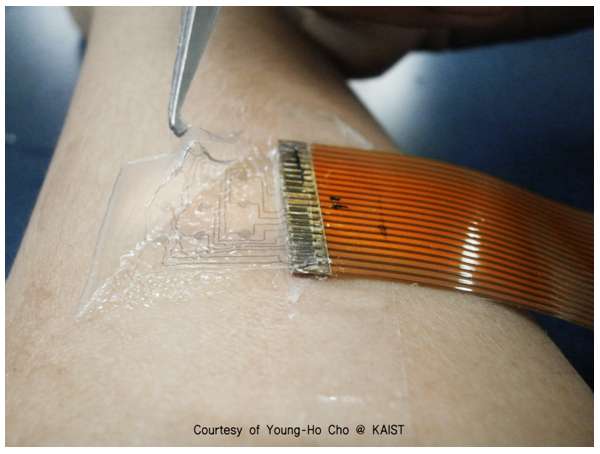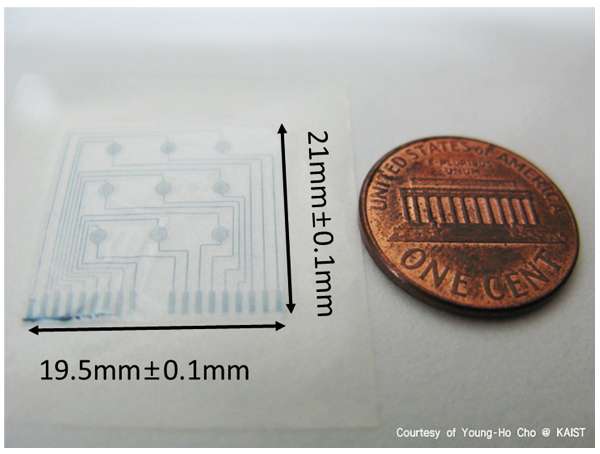The goosebump detector is a skin piloerection monitoring sensor conformally attached to the forearm. Credit: Young-Ho Cho @ KAIST
People get goosebumps when they feel a sudden surge of emotion. Goosebumps are due to the shrinkage of the skin cells around hairs, making the hairs stand on end. Animals, such as lions and cats, develop the goosebumps or "piloerection", and the hair standing on end makes them appear larger or stronger, especially when they feel fear or anger. Human skin also develops goosebumps on instinct when a person experiences a sudden change of emotion.
The world's first goosebump patch was developed by Professor Young-Ho Cho's team in the Bio & Brain Engineering Department at the Korea Advanced Institute of Science and Technology (KAIST). The thin flexible capacitive goosebump patch is able to measure the degree of human emotion quantitatively. An article on this new technology was published in Applied Physics Letters.
Professor Cho was inspired to develop the goosebump patch when watching a Sunday night TV program in Korea titled "I Am a Singer" on MBC-TV, which is a survival music contest program (2011~2012) where well-known singers were contestants and some of them were eliminated each week by an audience vote. Dr. Cho thought of a method to measure emotional response quantitatively and came up with the idea of the goosebump patch, capable of reading the signs of emotional response from the audience members' skin.
Professor Joseph Sakai, an M.D. at the University of Colorado School of Medicine, mentioned another application of quantitative goosebump sensors: research on adolescents with conduct problems and callous unemotional traits.
Currently, researchers at the NanoSentuating Systems Laboratory at KAIST are working on the criteria of emotional touch degrees or levels, expressed in terms of the area and intensity of goosebump responses. Professor Cho says that they are trying to calibrate goosebump responses based on the emotional sensitivities measured from the people exposed to the different kinds and levels of emotional stimulus.
Professor Cho explained, "The goosebump patch could be available in two or three years for applications to the extreme emotional response measurements based on the predefined personal emotional profile and emotion sensitivity." For a more sophisticate evaluation of human emotional response, he says it could take a little longer, say three to five years. With the introduction of his recent work on the self-powered emotion patch, which is integrated with flexible pulsewave power generators, he emphasizes the importance of the ethical issues of human emotion reading and monitoring.
The flexible band-aid patch (2cmx2cmx60um), composed of nine 1.5mm-diameter spiral capacitors for goosebump detection. Credit: Young-Ho Cho @ KAIST
Journal information: Applied Physics Letters






















